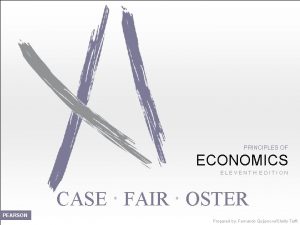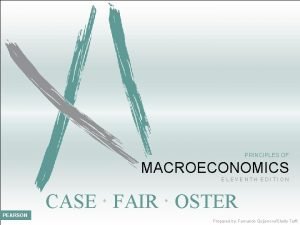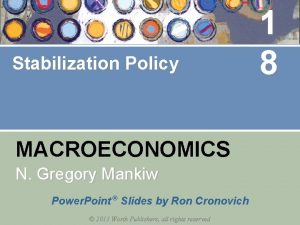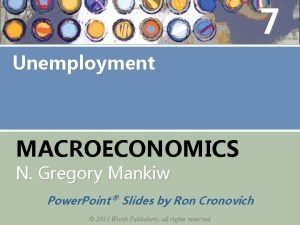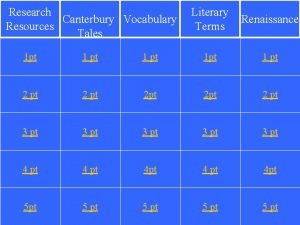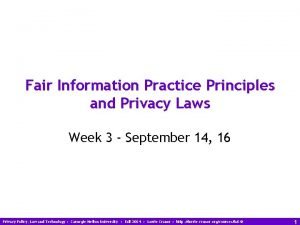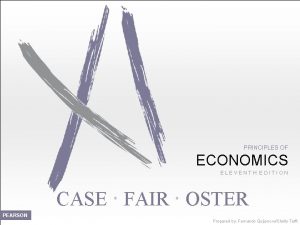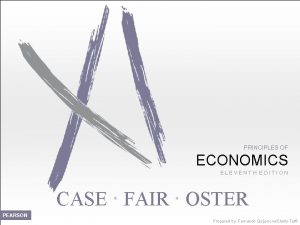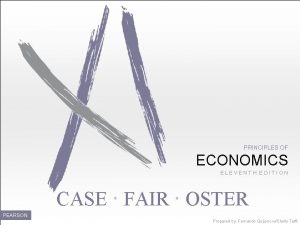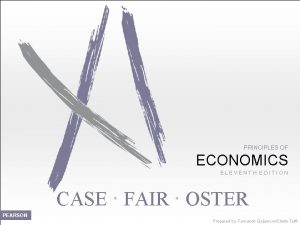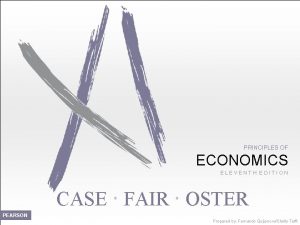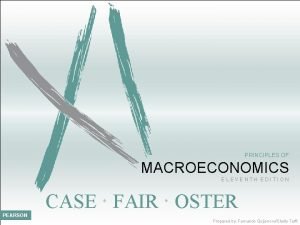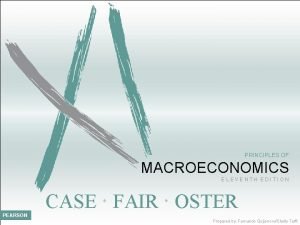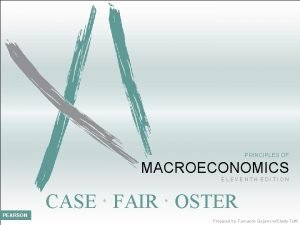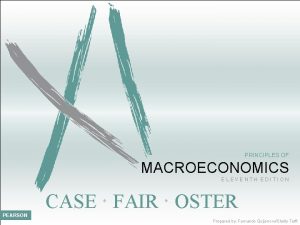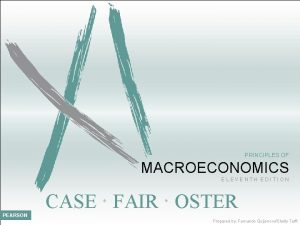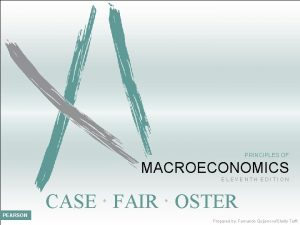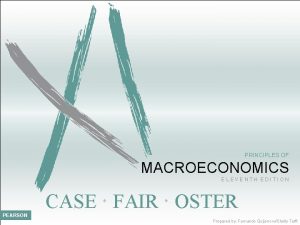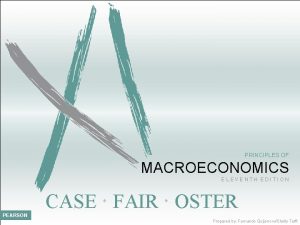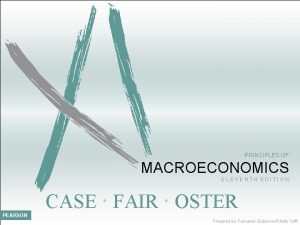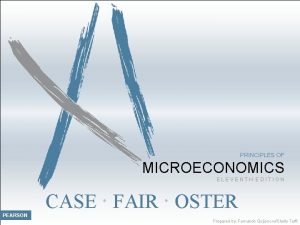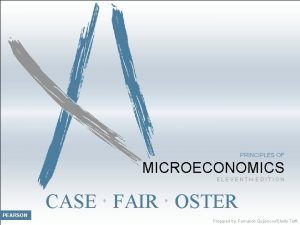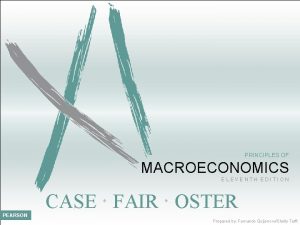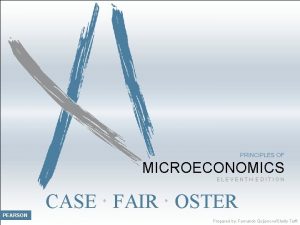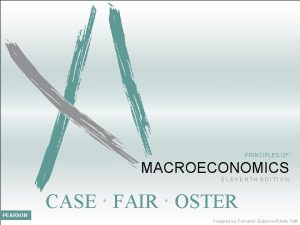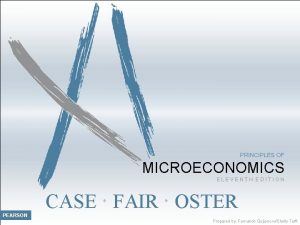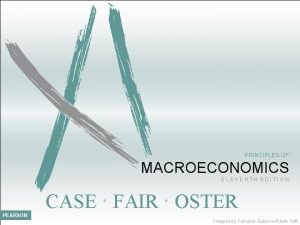PRINCIPLES OF ECONOMICS ELEVENTH EDITION CASE FAIR OSTER








































- Slides: 40

PRINCIPLES OF ECONOMICS ELEVENTH EDITION CASE FAIR OSTER PEARSON Prepared by: Fernando Quijano w/Shellyof. Tefft 40

© 2014 Pearson Education, Inc. 2 of 40

The Government and Fiscal Policy 24 CHAPTER OUTLINE Government in the Economy Government Purchases (G), Net Taxes (T), and Disposable Income (Yd) The Determination of Equilibrium Output (Income) Fiscal Policy at Work: Multiplier Effects The Government Spending Multiplier The Tax Multiplier The Balanced-Budget Multiplier The Federal Budget The Budget in 2012 Fiscal Policy Since 1993: The Clinton, Bush, and Obama Administrations The Federal Government Debt The Economy’s Influence on the Government Budget Automatic Stabilizers and Destabilizers Full-Employment Budget Looking Ahead Appendix A: Deriving the Fiscal Policy Multipliers Appendix B: The Case in Which Tax Revenues Depend on Income © 2014 Pearson Education, Inc. 3 of 40

fiscal policy The government’s spending and taxing policies. monetary policy The behavior of the Federal Reserve concerning the nation’s money supply. © 2014 Pearson Education, Inc. 4 of 40

Government in the Economy discretionary fiscal policy Changes in taxes or spending that are the result of deliberate changes in government policy. Government Purchases (G), Net Taxes (T), and Disposable Income (Yd) net taxes (T) Taxes paid by firms and households to the government minus transfer payments made to households by the government. disposable, or after-tax, income (Yd) Total income minus net taxes: Y − T. disposable income ≡ total income − net taxes Yd ≡ Y − T © 2014 Pearson Education, Inc. 5 of 40

FIGURE 24. 1 Adding Net Taxes (T) and Government Purchases (G) to the Circular Flow of Income © 2014 Pearson Education, Inc. 6 of 40

The disposable income (Yd) of households must end up as either consumption (C) or saving (S). Thus, Because disposable income is aggregate income (Y) minus net taxes (T), we can write another identity: By adding T to both sides: Planned aggregate expenditure (AE) is the sum of consumption spending by households (C), planned investment by business firms (I), and government purchases of goods and services (G). © 2014 Pearson Education, Inc. 7 of 40

budget deficit The difference between what a government spends and what it collects in taxes in a given period: G − T. budget deficit ≡ G − T Adding Taxes to the Consumption Function To modify our aggregate consumption function to incorporate disposable income instead of before-tax income, instead of C = a + b. Y, we write C = a + b. Yd or C = a + b(Y − T) Our consumption function now has consumption depending on disposable income instead of before-tax income. © 2014 Pearson Education, Inc. 8 of 40

Planned Investment The government can affect investment behavior through its tax treatment of depreciation and other tax policies. Planned investment depends on the interest rate, both of which we continue to assume are fixed for purposes of this chapter. © 2014 Pearson Education, Inc. 9 of 40

The Determination of Equilibrium Output (Income) Y=C+I+G TABLE 24. 1 Finding Equilibrium for I = 100, G = 100, and T = 100 (1) (2) (3) (4) (5) (6) (7) (8) (9) (10) Planned Unplanned Output Net Disposable Consumption Saving Investment Government Aggregate Inventory Adjustment (Income) Taxes Income Spending S Spending Purchases Expenditure Change to Disequi. Y T Yd ≡Y −T C = 100 +. 75 Yd Yd – C I G C + I + G Y − (C + I + G) librium 300 100 250 − 50 100 450 − 150 Output ↑ 500 100 400 0 100 600 − 100 Output ↑ 700 100 600 550 50 100 750 − 50 Output ↑ 900 100 800 700 100 100 900 0 1, 100 1, 000 850 100 1, 050 + 50 Output ↓ 1, 300 1, 200 1, 000 200 100 1, 200 + 100 Output ↓ 1, 500 1, 400 1, 150 250 100 1, 350 + 150 Output ↓ © 2014 Pearson Education, Inc. Equilibrium 10 of 40

FIGURE 24. 2 Finding Equilibrium Output/Income Graphically Because G and I are both fixed at 100, the aggregate expenditure function is the new consumption function displaced upward by I + G = 200. Equilibrium occurs at Y = C + I + G = 900. © 2014 Pearson Education, Inc. 11 of 40

The Saving/Investment Approach to Equilibrium saving/investment approach to equilibrium: S+T=I+G To derive this, we know that in equilibrium, aggregate output (income) (Y) equals planned aggregate expenditure (AE). By definition, AE equals C + I + G, and by definition, Y equals C + S + T. Therefore, at equilibrium: C+S+T=C+I+G Subtracting C from both sides leaves: S+T=I+G © 2014 Pearson Education, Inc. 12 of 40

Fiscal Policy at Work: Multiplier Effects At this point, we are assuming that the government controls G and T. In this section, we will review three multipliers: Government spending multiplier Tax multiplier Balanced-budget multiplier The Government Spending Multiplier government spending multiplier The ratio of the change in the equilibrium level of output to a change in government spending. © 2014 Pearson Education, Inc. 13 of 40

TABLE 24. 2 Finding Equilibrium after a Government Spending Increase of 50 (G Has Increased from 100 in Table 24. 1 to 150 Here) (1) (2) (3) (4) Output Net Disposable Consumption (Income) Taxes Income Spending Y T Yd ≡Y −T C = 100 +. 75 Yd (5) (6) (7) (8) (9) (10) Unplanned Planned Inventory Saving Investment Government Aggregate Adjustment Change S Spending Purchases Expenditure Y − (C + I + to Yd – C I G C+I+G G) Disequilibrium 300 100 250 - 50 100 150 500 - 200 Output ↑ 500 100 400 0 100 150 650 - 150 Output ↑ 700 100 600 550 50 100 150 800 - 100 Output ↑ 900 100 800 700 100 150 950 - 50 Output ↑ 1, 100 1, 000 850 100 150 1, 100 0 1, 300 1, 200 1, 000 200 150 1, 250 + 50 © 2014 Pearson Education, Inc. Equilibrium Output ↓ 14 of 40

FIGURE 24. 3 The Government Spending Multiplier Increasing government spending by 50 shifts the AE function up by 50. As Y rises in response, additional consumption is generated. Overall, the equilibrium level of Y increases by 200, from 900 to 1, 100. © 2014 Pearson Education, Inc. 15 of 40

The Tax Multiplier tax multiplier The ratio of change in the equilibrium level of output to a change in taxes. Because the initial change in aggregate expenditure caused by a tax change of ∆T is (−∆T × MPC), we can solve for the tax multiplier by substitution: Because a tax cut will cause an increase in consumption expenditures and output and a tax increase will cause a reduction in consumption expenditures and output, the tax multiplier is a negative multiplier: © 2014 Pearson Education, Inc. 16 of 40

The Balanced-Budget Multiplier balanced-budget multiplier The ratio of change in the equilibrium level of output to a change in government spending where the change in government spending is balanced by a change in taxes so as not to create any deficit. The balanced-budget multiplier is equal to 1: The change in Y resulting from the change in G and the equal change in T are exactly the same size as the initial change in G or T. © 2014 Pearson Education, Inc. 17 of 40

TABLE 24. 3 Finding Equilibrium after a Balanced-Budget Increase in G and T of 200 Each (Both G and T Have Increased from 100 in Table 24. 1 to 300 Here) (1) Output (Income) Y (2) (3) (4) Net Disposable Consumption Taxes Income Spending T Yd ≡Y − T C = 100 +. 75 Yd (5) (6) (7) (8) (9) Planned Unplanned Investment Government Aggregate Inventory Spending Purchases Expenditure Change I G C + I + G Y − (C + I + G) Adjustment to Disequilibrium 500 300 250 100 300 650 − 150 Output ↑ 700 300 400 100 300 800 − 100 Output ↑ 900 300 600 550 100 300 950 − 50 Output ↑ 1, 100 300 800 700 100 300 1, 100 0 1, 300 1, 000 850 100 300 1, 250 + 50 Output ↓ 1, 500 300 1, 200 1, 000 100 300 1, 400 + 100 Output ↓ © 2014 Pearson Education, Inc. Equilibrium 18 of 40

TABLE 24. 4 Summary of Fiscal Policy Multipliers Policy Stimulus Government spending multiplier Increase or decrease in the level of government purchases: ∆G Tax multiplier Increase or decrease in the level of net taxes: ∆T Balancedbudget multiplier Simultaneous balanced-budget increase or decrease in the level of government purchases and net taxes: ∆G = ∆T © 2014 Pearson Education, Inc. Multiplier Final Impact on Equilibrium Y 1 19 of 40

A Warning Although we have added government, the story told about the multiplier is still incomplete and oversimplified. We have been treating net taxes (T) as a lump-sum, fixed amount, whereas in practice, taxes depend on income. Appendix B to this chapter shows that the size of the multiplier is reduced when we make the more realistic assumption that taxes depend on income. We continue to add more realism and difficulty to our analysis in the chapters that follow. © 2014 Pearson Education, Inc. 20 of 40

The Federal Budget Because fiscal policy is the manipulation of items in the federal budget, that budget is relevant to our study of macroeconomics. federal budget The budget of the federal government. An enormously complicated document up to thousands of pages each year, the federal budget lists in detail all the things the government plans to spend money on and all the sources of government revenues for the coming year. It is the product of a complex interplay of social, political, and economic forces. © 2014 Pearson Education, Inc. 21 of 40

The Budget in 2012 TABLE 24. 5 Federal Government Receipts and Expenditures, 2012 (Billions of Dollars) Current receipts Personal income taxes Excise taxes and customs duties Corporate income taxes Taxes from the rest of the world Contributions for social insurance Interest receipts and rents and royalties Current transfer receipts from business and persons Current surplus of government enterprises Total Current expenditures Consumption expenditures Transfer payments to persons Transfer payments to the rest of the world Grants-in-aid to state and local governments Interest payments Subsidies Total Net federal government saving–surplus (+) or deficit (−) (Total current receipts − Total current expenditures) Amount Percentage of Total 1, 137. 8 116. 1 373. 7 17. 3 934. 8 53. 4 59. 2 − 17. 8 2, 674. 5 42. 5 4. 3 14. 0 0. 6 35. 0 2. 2 − 0. 7 100. 0 1, 059. 6 1, 773. 2 76. 4 468. 0 318. 5 60. 4 3, 756. 1 28. 2 47. 2 2. 0 12. 5 8. 5 1. 6 100. 0 − 1, 081. 6 federal surplus (+) or deficit (−) Federal government receipts minus expenditures. © 2014 Pearson Education, Inc. 22 of 40

Fiscal Policy Since 1993: The Clinton, Bush, and Obama Administrations FIGURE 24. 4 Federal Personal Income Taxes as a Percentage of Taxable Income, 1993 I– 2012 IV © 2014 Pearson Education, Inc. 23 of 40

FIGURE 24. 5 Federal Government Consumption Expenditures as a Percentage of GDP and Federal Transfer Payments and Grants-in-Aid as a Percentage of GDP, 1993 I– 2012 IV © 2014 Pearson Education, Inc. 24 of 40

FIGURE 24. 6 The Federal Government Surplus (+) or Deficit (−) as a Percentage of GDP, 1993 I– 2012 IV © 2014 Pearson Education, Inc. 25 of 40

ECONOMICS IN PRACTICE The U. S. Congress Fights about the Budget In January 2013, Congress signed the American Tax Relief Act (ATRA), which retained many of the earlier Bush tax cuts, while modifying others. But the specter of automatic spending cuts remained. In the spring of 2013, arguments about the shape of the 2014 budget were raging, as members of the House commented on a budget proposal of Paul Ryan, Republican Congressman from Wisconsin. Representative Eddie Bernice Johnson of Texas, a Democrat, had this to say about Congressman Ryan’s bill: “This budget would not only jeopardize seniors, families and the most vulnerable in our society, it would also destroy jobs and put our nation’s economic recovery at risk. ” The Congress heard a different view from Andy Barr, a new Republican Congressman from Kentucky: “Families and small businesses should be able to keep more of their hard-earned income instead of having it wasted by Washington bureaucrats. ” THINKING PRACTICALLY 1. How would you describe the views of the two people quoted on the benefits of government spending? © 2014 Pearson Education, Inc. 26 of 40

The Federal Government Debt federal debt The total amount owed by the federal government. privately held federal debt The privately held (non-government-owned) debt of the U. S. government. © 2014 Pearson Education, Inc. 27 of 40

FIGURE 24. 7 The Federal Government Debt as a Percentage of GDP, 1993 I– 2012 IV © 2014 Pearson Education, Inc. 28 of 40

ECONOMICS IN PRACTICE The Debt Clock Next time you are in New York City, wander by West 44 th Street and the Avenue of the Americas. Located on an outside wall is a U. S. Debt Clock, mounted by Seymour Durst, a N. Y. real estate developer. Rather than showing us the passage of time, as would a conventional clock, this clock shows us the mounting of the U. S. debt. Durst was an early worrier about the debt! Needless to say, it sped up during the Obama administration. See Figure 24. 7. THINKING PRACTICALLY 1. For a few years beginning in 2000, the clock was stopped and covered up. Can you guess why based on the data you have seen in this chapter? © 2014 Pearson Education, Inc. 29 of 40

The Economy’s Influence on the Government Budget Automatic Stabilizers and Destabilizers automatic stabilizers Revenue and expenditure items in the federal budget that automatically change with the state of the economy in such a way as to stabilize GDP. automatic destabilizer Revenue and expenditure items in the federal budget that automatically change with the state of the economy in such a way as to destabilize GDP. fiscal drag The negative effect on the economy that occurs when average tax rates increase because taxpayers have moved into higher income brackets during an expansion. © 2014 Pearson Education, Inc. 30 of 40

Full-Employment Budget full-employment budget What the federal budget would be if the economy were producing at the full-employment level of output. structural deficit The deficit that remains at full employment. cyclical deficit The deficit that occurs because of a downturn in the business cycle. © 2014 Pearson Education, Inc. 31 of 40

Looking Ahead We have now seen how households, firms, and the government interact in the goods market, how equilibrium output (income) is determined, and how the government uses fiscal policy to influence the economy. In the following two chapters, we analyze the money market and monetary policy—the government’s other major tool for influencing the economy. © 2014 Pearson Education, Inc. 32 of 40

REVIEW TERMS AND CONCEPTS automatic destabilizers privately held federal debt automatic stabilizers structural deficit balanced-budget multiplier tax multiplier budget deficit Disposable income Yd ≡ Y − T cyclical deficit AE ≡ C + I + G discretionary fiscal policy Government budget deficit ≡ G − T disposable, or after-tax, income (Yd) Equilibrium in an economy with a government: Y = C + I + G federal budget federal debt federal surplus (+) or deficit (−) fiscal drag fiscal policy Saving/investment approach to equilibrium in an economy with a government: S + T = I + G Government spending multiplier full-employment budget government spending multiplier 7. Tax multiplier ≡ monetary policy net taxes (T) © 2014 Pearson Education, Inc. 8. Balanced-budget multiplier ≡ 1 33 of 40

CHAPTER 24 APPENDIX A Deriving the Fiscal Policy Multipliers The Government Spending and Tax Multipliers We can derive the multiplier algebraically using our hypothetical consumption function: The equilibrium condition is By substituting for C, we get This equation can be rearranged to yield Now solve for Y by dividing through by (1 − b): © 2014 Pearson Education, Inc. 34 of 40

The Balanced-Budget Multiplier It is easy to show formally that the balanced-budget multiplier = 1. initial increase in spending: − initial decrease in spending: = net initial increase in spending In a balanced-budget increase, ∆G = ∆T; so in the above equation for the net initial increase in spending we can substitute ∆G for ∆T. ∆G − ∆G (MPC) = ∆G (1 − MPC) © 2014 Pearson Education, Inc. 35 of 40

Because MPS = (1 − MPC), the net initial increase in spending is: ∆G (MPS) We can now apply the expenditure multiplier increase in spending: to this net initial Thus, the final total increase in the equilibrium level of Y is just equal to the initial balanced increase in G and T. © 2014 Pearson Education, Inc. 36 of 40

CHAPTER 24 APPENDIX B The Case in Which Tax Revenues Depend on Income FIGURE 24 B. 1 The Tax Function This graph shows net taxes (taxes minus transfer payments) as a function of aggregate income. © 2014 Pearson Education, Inc. 37 of 40

FIGURE 24 B. 2 Different Tax Systems When taxes are strictly lump-sum (T = 100) and do not depend on income, the aggregate expenditure function is steeper than when taxes depend on income. © 2014 Pearson Education, Inc. 38 of 40

The Government Spending and Tax Multipliers Algebraically We know that Y = C + I + G. Through substitution we get Solving for Y: © 2014 Pearson Education, Inc. 39 of 40

This means that a $1 increase in G or I (holding a and T 0 constant) will increase the equilibrium level of Y by Holding a, I, and G constant, a fixed or lump-sum tax cut (a cut in T 0) will increase the equilibrium level of income by © 2014 Pearson Education, Inc. 40 of 40
 Principles of economics case fair oster
Principles of economics case fair oster Principles of macroeconomics case fair oster
Principles of macroeconomics case fair oster Eleventh edition management
Eleventh edition management Management eleventh edition
Management eleventh edition Management eleventh edition
Management eleventh edition Management eleventh edition stephen p robbins
Management eleventh edition stephen p robbins Vicky thorland-oster
Vicky thorland-oster Oster 3000
Oster 3000 How to become known on twitter
How to become known on twitter Principles of economics third edition politeknik
Principles of economics third edition politeknik Principles of economics mankiw 9th edition ppt
Principles of economics mankiw 9th edition ppt Rational people think at the margin
Rational people think at the margin Principles of economics mankiw 9th edition ppt
Principles of economics mankiw 9th edition ppt Bhore committee
Bhore committee Eleventh 5 year plan
Eleventh 5 year plan Thfive
Thfive For his eleventh birthday elvis presley
For his eleventh birthday elvis presley Sonnet has 14 lines
Sonnet has 14 lines Foul is fair and fair is foul literary device
Foul is fair and fair is foul literary device Aside literary device
Aside literary device Foul is fair and fair is foul
Foul is fair and fair is foul What is syntax rhetorical device
What is syntax rhetorical device Fair play ne demek
Fair play ne demek Examples of fair is foul and foul is fair in macbeth
Examples of fair is foul and foul is fair in macbeth Best worst and average case
Best worst and average case Mis chapter 6
Mis chapter 6 Using mis 10th edition
Using mis 10th edition Modern labor economics 12th edition solution
Modern labor economics 12th edition solution Modern labor economics 12th edition pdf
Modern labor economics 12th edition pdf Economics michael parkin 13th edition
Economics michael parkin 13th edition Managerial economics hirschey
Managerial economics hirschey Markup economics
Markup economics Modern labor economics 12th edition
Modern labor economics 12th edition Economics and business economics maastricht
Economics and business economics maastricht Non mathematical economics
Non mathematical economics Fair principles
Fair principles Fair information practice principles
Fair information practice principles Failure of supporting utilities and structural collapse
Failure of supporting utilities and structural collapse Principles of electronic communication systems 3rd edition
Principles of electronic communication systems 3rd edition Computer security principles and practice
Computer security principles and practice Accounting principles second canadian edition
Accounting principles second canadian edition
